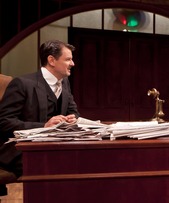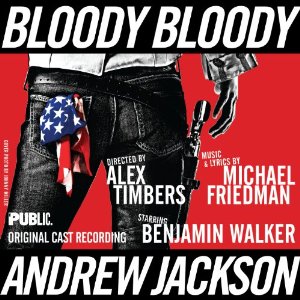SITE GUIDE
SEARCH
REVIEWS
REVIEW ARCHIVES
ADVERTISING AT CURTAINUP
FEATURES
NEWS
Etcetera and
Short Term Listings
LISTINGS
Broadway
Off-Broadway
NYC Restaurants
BOOKS and CDs
OTHER PLACES
Berkshires
London
California
New Jersey
DC
Connecticut
Philadelphia
Elsewhere
QUOTES
TKTS
PLAYWRIGHTS' ALBUMS
LETTERS TO EDITOR
FILM
LINKS
MISCELLANEOUS
Free Updates
Masthead
A CurtainUp Review
What the Public Wants
By Elyse Sommer
|
People say that no one can make a million in ten years and not be a scoundrel. But I did. I've never tried to ruin a competitor. I've never sweated my men. They have to work hard, and I'd sack one as soon as look at him, but they are well paid — some of 'em are handsomely paid. The price of labour in journalism has gone up, and it's thanks to me.—Sir Charles Worgan Yes, but how did you do it? What's your principle?— Francis Worgan I've only got one principle. Give the public what it wants. Don't give the public what you think it ought to want, or what you think would be good for it; but what it actually does want. . . I've got no moral axes to grind. I'm just a business man. Sir Charles |

Rob Breckenridge at his desk, piled high with some of the papers he runs on the principle of giving the public what it wants.
(Photo: Richard Termine) |
Lke me, you probably know Arnold Bennett mostly as a novelist, but he was also well-known for his j other endeavors which included theater criticism and a number of well-regarded plays such as What the People Want. If Bennett's fictional newspaper tycoon, Sir Charles Worgan, were to materialize as a real presence at preparations for this revival, he might well diddle around with the original script as in the play he meddles in the creative process of a prestigious theater company he rescues from financial insolvency — not because he is a theater buff but in order to boost his social standing and win the affections of Emily Vernon, one of the theater's employees who also comes from his home town, Bursley (one of the Five Towns of Bennett's best known novels, notably The Old Wives' Tale, Clayhanger and Hilda Lessways).
Sir Charles might well trim the four act play to 90 minutes without an intermission and add a bit of sexual sizzle to the relationship between his character (who's actually quite inexperienced and shy when it comes to women) and the pretty widow he sees as adding love and prestige to his financial success. Who knows, he might even move the action into the present with sleek, modern decor and costumes.
But true to the Mint's always authentic as well as enjoyable revivals, director Matthew Arbour has remained true to Bennett's clever script. He leaves it to the actors — especially Rob Breckenridge as the self-made millionaire publisher inspired by Lord Northcliffe who founded Britain's leading tabloid, The Daily Mail — to bring the characters to vivid life.
Authenticity permeates the play's look as well as action, with Roger Hanna's set true to a 1906 office. The most up to date equipment in Sir Charles' wood paneled office is a dictaphone machine; also an amusing manually operated apparatus with different colored light disks to signal his availability or lack thereof to any outer office employees or visitors.
But for all that we're back in a decidedly non -high tech newspaper office free of concerns about the Internet and social networking turning print news into an endangered species, the issues explored in What the Public Wants are as relevant today as they were a century ago: the philosophical divide between business oriented tycoons and more traditional, news and truth oriented journalists. Worgan, sees himself as a merchant, with his papers built around the principle of giving his readers what they want and to the devil with the more ethically correct journalistic commitment to giving them what they ought to want: truthful, unembellished news — not to mention articles carefully proofed to avoid linguistic offenders like split infinitives.
While the Mint has become one of New York's theatrical treasures and has built up a loyal following, it hasn't made Artistic Director Jonathan Bank a theatrical tycoon with a big enough budget to pay star-worthy salaries to its actors and designers. Fortunately, the company has attracted design professionals who can do wonders with less than million dollar budgets and actors who can do justice to these wonderful newly minted old plays, and, as needed, play multiple roles. In fact, the economically dictated multi-tasking often adds a fun touch -- as is illustrated here, especially by Jeremy Lawrence who plays an outraged theater critic in act one, an even angrier, arts-y theater manager in the second act, and a gossipy business owner in the one scene that takes us away from Worgan's London office to his rarely visited home town in the Five Towns. It's here that Worgan's people pleasing principle is put to the ultimate test.
There's no question that Sir Charles Worgan is the play's central and most interesting character and his publishing business the foundation stone for the plot. However, we also have strong contributions from the other characters who walk into Worgan's office when that light bulb apparatus at the door turns green to indicate his availability. The strong ensemble work makes for a well-constracted drama that merges business and personal relationships and balances serious issues with comedy.
Worgan's reunion with his long-absent brother Francis (a finely understated Marc Vietor) not only fills us in on the Worgan family dynamic which involves three brothers. Sir Charles is the one who has used the ten thousand pounds each inherited to become the wealthiest Worgan. His oldest brother John (Douglas Rees, who with a flip of a hair piece alternates with the Worgan newspapers' manager, Saul Kendrick) is married with children and has remained in Bursley practicing medicine. Francis, the most intellectual brother, has wandered the world managing to live off the modest income of their inheritance, and is intrigued enough to offer himself up as his brother's drama critic, when the current critic quits in an outrage because his latest impeccably correct pieces have been mis-edited -- most egregiously with the addition of a split infinite.
Adding Francis to his brother's inner circle gives us an involved yet very un-Charles like observer. Francis also manages to make his brother more amenable to the idea of matrimony, especially since the widowed Emily is not just pretty but smart and likely to enhance Charles' success by adding social cachet as well as love to his life. Unaccustomed as Charles is to conducting a romance, Emily's connection to the cash-poor Prince's Theatre eases his path in that effort. Breckenridge manages to be almost endearing in his portrayal of Charles as an enthusiastic entrepreneur who's quite self-assured about his less than admirable devotion to profitable but often inaccurate journalism but at the same time quite shy when it comes to romance. That mix of enthusiasm, ruthlessness and , and awkwardness make him more flawed anti-hero than out and out villain.
The triple arches of Hanna's set ingeniously allow the action to shift to the Five Towns scene where Sir Charles's principles lead to differences that lead to the climactic final act back in the Worgan offices. Whether the ending surprises you or not, it will leave you wondering why they don't write plays with satisfyingly twisty endings like this any more.
|
What the Public Wants Playwright: Arnold Bennett Director: Matthew Arbour Cast: Ellen Adair (Emily), Mary Baird (Mrs. Downes), Rob Breckenridge (Sir Charles Worgan), Birgit Huppuch (Henrietta/Annie Worgan), Laurie Kennedy (Mrs. Worgan), Jeremy Lawrence (Simon MacQuoid/ Holt St. John/ James Brindley), Douglas Rees (Kendrick/John Worgan), Marc Vietor (Francis Worgan). Set desig: Rodger Hanna— Costume design:Erin Murphy Lighting design: Marcus Doshi Sound design: Daniel Kluger Stage Manager: Kathy Snyder Running Time: 2 1/2 hours, includes 2 intermissions Mint Theater 311 West 43rd Street (212) 315-0231 Tickets: $55 From 1/14/11; opening 1/27/27/11;closing 3/13/11 Tue-Thursdays at 7:00pm, Fri and Sat at 8pm, Saturday and Sunday at 2pm Reviewed by Elyse Sommer at January 23rd press matinee |
|
REVIEW FEEDBACK Highlight one of the responses below and click "copy" or"CTRL+C"
Paste the highlighted text into the subject line (CTRL+ V): Feel free to add detailed comments in the body of the email. . .also the names and emails of any friends to whom you'd like us to forward a copy of this review. Visit Curtainup's Blog Annex For a feed to reviews and features as they are posted add http://curtainupnewlinks.blogspot.com to your reader Curtainup at Facebook . . . Curtainup at Twitter Subscribe to our FREE email updates: E-mail: esommer@curtainup.comesommer@curtainup.com put SUBSCRIBE CURTAINUP EMAIL UPDATE in the subject line and your full name and email address in the body of the message. If you can spare a minute, tell us how you came to CurtainUp and from what part of the country. |

Slings & Arrows-the complete set
You don't have to be a Shakespeare aficionado to love all 21 episodes of this hilarious and moving Canadian TV series about a fictional Shakespeare Company






